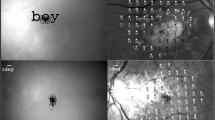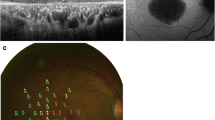Abstract
Purpose
The purpose of this study was to explore the presence of the filling-in phenomenon in patients with uni- or bilateral central scotoma (CS) resulting from natural history or laser photocoagulation of choroidal neovascularization in age-related macular degeneration (AMD).
Methods
Sixteen consecutive patients with unilateral CS and 14 patients with bilateral CS were assessed (44 eyes) with a scanning laser ophthalmoscope (SLO). Scotoma was delineated by scotometry with a point (1°×1°) moving radially from the periphery to the center of the lesion. In addition, patients underwent a line test, consisting of a horizontal line moving vertically and a vertical line moving horizontally, from the periphery to the center. The lines were longer than the macular lesion and were projected onto the retina. Patients were asked to indicate when the lines seemed interrupted. The perceptual filling-in phenomenon was considered to be present when limits of the perceived scotoma, determined by the line test, were smaller than those assessed by scotometry. In patients with bilateral CS, the results were analyzed to distinguish the less or more severely affected eye.
Results
In all eyes, the limits of the scotoma obtained with the scotometry test corresponded to the anatomic edges of the macular lesion. In patients with bilateral CS, the filling-in phenomenon was observed in 12 out of 14 (85%) less severely affected eyes, but only in one (7%) of their more severely affected eyes. In patients with unilateral CS, the phenomenon was observed in only one out of 16 (6%) eyes.
Conclusion
These results suggest that the filling-in phenomenon mostly occurs in patients with bilateral central scotoma, and almost always in their less affected eye. Thus, it did usually not occur in an eye if the fellow eye was better.




Similar content being viewed by others
References
Achard OA, Safran AB, Duret FC, Ragama E (1995) Role of the completion phenomenon in the evaluation of Amsler grid results. Am J Ophthalmol 120:322–329
Chino YM, Kaas JH, Smith EL III, Langston AL, Cheng H (1992) Rapid reorganization of cortical maps in adult cats following restricted deafferentation in retina. Vision Res 32:789-796
Cohen SY, LeGargasson JF, Safran A (2000) Adaptation au scotome central bilateral. In: Cohen SY et al, Guide pratique de rééducation des basses visions. Elsevier, Paris, pp 64–65
Cohen-Sabban J, Rodier JC, Roussel A, Simon J (1984) Ophtalmoscopie par balayage optique. Innov Techn Biol Med 5:116–128
Coscas GJ, Soubrane G, Ramahefasolo C, Fardeau C (1991) Perifoveal laser treatment for subfoveal new vessels in age-related macular degeneration. Arch Ophthalmol 109:1258–1265
Darian-Smith C, Gilbert CD (1995) Topographic reorganization in the striate cortex of the adult cat and monkey is cortically mediated. J Neurosci 15:1631–1647
Das A, Gilbert CD (1995) Long-range horizontal connections and their role in cortical reorganization revealed by optical recording of cat primary visual cortex. Nature 375:780–784
De Weerd, P, Gattas R, Desimone R, Ungerleiden LG (1995) Responses of cells in monkey visual cortex during perceptual filling-in of an artificial scotoma. Nature 377:731–734
De Weerd P, Desimone R, Ungerleiden LG (1998) Perceptual filling-in: a parametric study. Vision Res 38:2721–2734
Doris N, Hart PM, Chakravarthy U, et al (2001) Relation between macular morphology and visual function in patients with choroidal neovascularisation of age-related macular degeneration. Br J Ophthalmol 85:184–188
Dosso AA, Ustun-Yenice F, Safran AB (2000) Scotomata from panretinal photocoagulation are not perceived as a result of perceptual filling-in generated by plasticity in the visual cortex. Diabetes Care 23:1855
El Mallah MK, Chakravarthy U, Hart PM (2000) Amblyopia: Is visual loss permanent? Br J Ophthalmol 84:952–956
Fasce F, Brancato R, Bettin P, Introini U, Pece A (1996–1997) Evaluation of fixation 1 year after perifoveal laser treatment of subfoveal choroidal neovascularization. Int Ophthalmol 20:251–258
Gilbert CD, Wiesel TN (1992) Receptive field dynamics in adult primary visual cortex. Nature 356:150–152
Grüsser OJ, Landis T (1991) Visual agnosias and other disturbances of visual perception and cognition. In: Landis T (ed) Vision and visual dysfunction. Macmillan, London, pp 151–157
Heinen SJ, Skavenski AA (1992) Adaptation of saccades and fixation to bilateral foveal lesions in adult monkey. Vision Res 32:365–373
Hendry S, Bandhari MA (1992) Neuronal organization and plasticity in adult monkey visual cortex: Immunoreactivity for microtubule-associated protein 2. Vis Neurosci 9:445–459
Kass JH (1995) How cortex reorganizes. Nature 375:735–736
Le Gargasson JF, Rigaudiere F, Guez JE, Gaudric A, Grall Y (1994) Contribution of SLO to the functional investigation of subjects with a macular hole. Doc Ophthalmol 86:227–238
Levitt JB, Yoshioka T, Lund JS (1994) Intrinsic cortical connections in macaque visual area V2: Evidence for interaction between different visual streams. J Comp Neurol 342:551–570
Marshall J, Bird AC (1979) A comparative histopathological study of argon and krypton laser irradiations of the human retina. Br J Ophthalmol 63:657–668
Pettet MW, Gilbert CD (1992) Dynamic changes in receptive field size in cat primary visual cortex. Proc Natl Acad Sci USA 89:8366–8370
Ramachandran VS, Gregory RL (1991) Perceptual filling in of artificially induced scotomas in human vision. Nature 350:699–702
Safran AB, Landis T (1999) From cortical plasticity to unawareness of visual field defects. J Neuroophthalmol 19:84–88
Safran AB, Duret F, Issenhuth M, Mermoud C (1999) Full text reading with a central scotoma: pseudoregressions and pseudoline losses. Br J Ophthalmol 83:1341–1347
Safran AB, Achard O, Duret F, Landis T (1999) The "thin man" phenomenon: A sign of cortical plasticity following inferior paracentral scotomas. Br J Ophthalmol 83:137–142
Schuchard RA (1993) Validity and interpretation of Amsler grid reports. Arch Ophthalmol 111:776–780
Sergent J (1998) An investigation into perceptual completion in blind areas of the visual field. Brain 111:347–373
Singerman LJ, Wong B, Ai E, Smith S (1985) Spontaneous visual improvement in the first affected eye of patients with bilateral disciform scars. Retina 5:135–143
Spillmann L, Kurtenbach A (1992) Dynamic noise backgrounds facilitate target fading. Vision Res 32:1941–1946
Sunness JS, Applegate CA, Gonzalez-Baron J (2000) Improvement of visual acuity over time in patients with bilateral geographic atrophy from age-related macular degeneration. Retina 20:162–169
Sunness JS, Schuchard RA, Shen N, Rubin GS, Dagnelie G, Haselwood DM (1995) Landmark-driven fundus perimetry using the scanning laser ophthalmoscope. Invest Ophthalmol Vis Sci 36:1863–1874
Tripathy SP, Levi DM, Ogmen H, Harden C (1995) Perceived length across the physiological blind spot. Vis Neurosci 12:385–402
Author information
Authors and Affiliations
Corresponding author
Rights and permissions
About this article
Cite this article
Cohen, S.Y., Lamarque, F., Saucet, JC. et al. Filling-in phenomenon in patients with age-related macular degeneration: differences regarding uni- or bilaterality of central scotoma. Graefe's Arch Clin Exp Ophthalmol 241, 785–791 (2003). https://doi.org/10.1007/s00417-003-0744-3
Received:
Revised:
Accepted:
Published:
Issue Date:
DOI: https://doi.org/10.1007/s00417-003-0744-3




